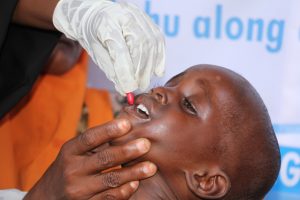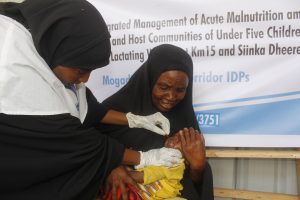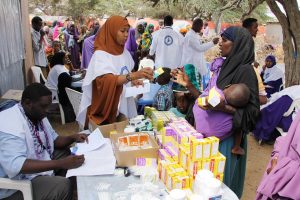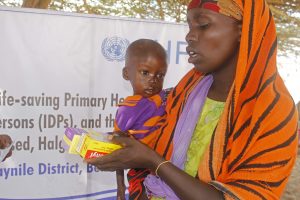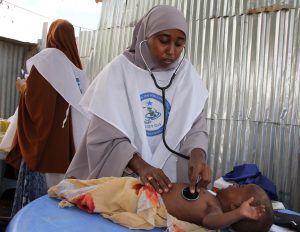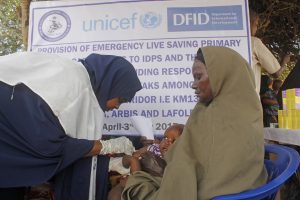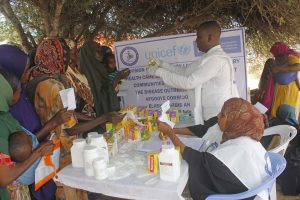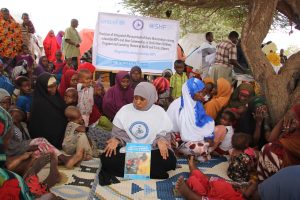
- Executive summary.
In the onset of the severe drought in Somalia several regions have been highly hits by the effect of the drought, however, Lower Shabelle and Banadir regions where SOYDA operationalized its core programs have not been left away and has its fair share of serious nutrition problems that are resulting in adverse human development outcomes, including health and hindering child growth. This is coupled with lack of coordinated response in all sectors such as livelihood and protections hence having the highest under-five mortality rates (U5MR) as well as poor maternal and child health and nutrition contributing to more of child deaths.
Despite improve security and lifesaving programs in Banadir and lower Shabelle region; the region still remains high at SAM burden of 15%. Furthermore, more than 40% of the population lives below the poverty line. Subsistence agriculture remains the primary livelihood for the majority of the population in Lower Shabelle with maize, sorghum, and bananas the most commonly grown crops. There are significant geographical disparities in access to health services only 40 % of the population, similarly in urban areas, 10% of the population has access to an improved drinking water source and 16% of the population has access to an improved sanitation facility; however, in rural areas these rates drop to 20% and 6%, respectively.
In addition to growing the risk of mortality among children due to above mention problem, high levels of chronic and acute malnutrition increase the exposure to, duration, and severity of various morbidities, which can put an excessive load on the health system. Under nutrition in the early years of a child’s life can also cause permanent cognitive impairments, which will prevent Somalia economic productivity and development, primarily through compromising their school performance, and labor productivity as an adult.
The impact of the drought on the food availability and security for the structurally vulnerable population groups went beyond food deficit, also distressing the agricultural production-base affecting the water availability, availability of agricultural inputs, etc. This further impacted the productivity, the seeds for the next agricultural campaign and the producers’ capacity to reimburse credit was affected negatively. SOYDA health and nutrition facilities reports confirmed an increasing trend of persons with reduced food intake, as well as the risks associated with acute malnutrition, illness (morbidity) and death (mortality) among the most exposed and vulnerable groups, especially young children and lactating women.
- Program effectiveness.
Bassed on the experience learnt under the previous month emergency program, SOYDA identified need areas to be supported under the OTP program as well as mobile clinic in the primary healthcare services, Further, staffs continuously assessed the needs and security situation – the rural outreach revealed that the communities in these areas have highest vulnerability as compared to the urban and pre-urban areas in Lower Shabelle.
SOYDA interventions came at a time when communities were in need of nutrition and health interventions, opportunities, as well as protection against rampant violations in the IDPs camps. Assessments conducted by SOYDA have shown that IDPs were particularly vulnerable to domestic violence and harassments. The projects have showed reports of defaulters are high in the rural areas compared to the urban population.
The overall program management was assured by strong capacities in planning, implementation and monitoring through a very qualified and well-organized team and leaderships in Lower Shabelle and Banadir region. It worked through integration of health programs in which SOYDA was also in partnership with SHF, DFID and UNICEF Somalia. Clear targeting and selection strategies, program implementation plans, strategies, targets, program exit and handover strategies were developed and documented in the initial program periods. During the community meeting, it was clear that majority of local stakeholders involved, even though few beneficiaries understood the process. This was in associated with the fact that with heightened risks of humanitarian workers, it was not possible for staffs to spend long periods within the community to sensitize the beneficiaries and validate the targeting and selection process.
The all programs adopted an effective participatory approach for assessing community needs and designing the interventions. The technical designs and choice of interventions considered the needs of the beneficiaries and technical viability of the structures in the different geographical locations. Supplement distribution (RUTF) involved the beneficiaries directly by engaging them through mobile and static nutrition interventions as well as mobile clinic, an excellent approach that provided immediate lifesaving and life sustaining health and nutrition intervention in the target locations.
The program produced important immediate results that show high prospects for larger impacts. Within its limited scope, the program reached vulnerable households as well as enabling essential community. During the program implementation, the community members expressed their satisfaction, and it was clear their relationship was very good. The community nutrition education improved health and nutrition seeking behaviour of the communities, through the effective community health workers engagement on daily screening and referral as well as the trained traditional birth attendance who have visited the homes time to time in order to ensure the pregnant mothers deliver safely at SOYDA facilities.
On the other hand IMAM/IYCF and NHHP training, sensitization and awareness sessions – a total of 39 CHW/promoters training (16 males and 23 women) for 5 days sessions were conducted. The BSNP/IMAM trainees spearheaded the sensitization awareness campaigns carried out in the target location to increase SAM reporting while the sessions were aimed at bettering the understanding of IMAM prevention and response among the community health workers.
The program concentrated on strengthening staff capacities to develop, implement and monitor effective program interventions concerning the access to adequate and efficient health and nutrition lifesaving interventions. The interventions aimed under this program have been developed in support of the SOYDA priorities highlighted in regards to children, health and Nutrition, as well as the donor/cluster strategy to reduce under-five mortality.
- Program activity achievement.
In this reporting months, 1657 pregnant women attended antenatal care (ANC) visits, with 249 attending one comprehensive ANC visits. It is important to note that several pregnant women have benefited from ANC visits. These women are not included in the above data since the hospital is a referral facility that receives a wide range of clients from even the neighboring district and SOYDA facilities does not segregate the data to be able to capture those referred from other IDPs supported by this project. In the future, the project will work in an integrated manner to ensure that all ANC visits attributable to the Action are captured.
The total numbers of skilled care deliveries continued to rise across this reporting month. By mid-April, 2017, the proportion of skilled care deliveries was 13.4% as reported by SOYDA mobile clinic indicator tracking report from January to April 2017. The project supported activities fostering skilled care deliveries and there were 46 skilled care deliveries conducted from in the months of April 2017 in the facilities supported by SOYDA project. The increase in numbers is probably a result of the door-to-door mobilization technique used by the CHWs and the improved attitude of health facility staff.
SOYDA is however, is scaling up the drought response to the displaced persons from other neighboring regions and already reached nearly 8758 people with improved access to outpatient therapeutic program (OTP) and Emergency primary healthcare, doubling its response from January. Further scale-up is urgently required across all sectors. Priorities include treatment and prevention of AWD/Cholera, improved access to food and safe water, nutritional treatment for malnourished children, protection to newly displaced person arriving at KM 13, Km15, Siinkadheer, Arbis, Lafole, Elasha and Kordamac IDPs in Daynile District, Benadir Region
More significantly, the organization is on top of the intervention where it gives high case managements at facilities in KM 13, Km15, Siinkadheer, Arbis, Lafole, Elasha and Horsed, Halgan and Kordamac IDPs in Daynile District, Benadir Region. This is through the funding from UNICEF, CHF and DFID and has realy facilitated the the response to the vulnerable population. Since the beginning of the year SOYDA have noted significant influence on child nutrition of particular concern are feeding practices (such as the low rates of exclusive breast-feeding in the first 3 months and the low frequency of active feeding of infants) and inadequate hygiene practices relating to food preparation
The technical training for all the 39 CHWs was done from 23th April to 27th April 2017. The training was facilitated by training consultant and coordinated by SOYDA project field manager. It covered the following topics: roles and responsibilities of CHVs; home visit timings; counseling skills; focused antenatal care; promoting antenatal care; importance of nutrition in the community; food and personal hygiene; family planning and birth spacing as well as record keeping.
Understandably, the project training implied social analysis and action model, community mobilization model and process, SAA approach, basic technical knowledge on the project thematic areas, facilitation skills, and the application of selected community dialogue tools. The trained have remained active in engaging the community throughout the project reporting months of April, through community-organized forums and open dialogues. To date, they have conducted 4 community dialogues reaching out to an average population of 2,741 beneficiaries. Due to increased demand, the project team also integrated the social analysis action as part of the mobilization strategy into community and facility-organized outreaches. They engage the crowd on harmful socio-cultural norms before they are offered health care services. This has improved the turnout during the outreaches and created synergy with the health talks provided by health care providers.
The targeted communities are increasingly aware of and demanding services on MNCH, family planning and nutrition, as shown by the increase in the number of clients accessing integrated services. The demand and mobilization are resulting from a combined effort of CHWs through morning health talks and the provision of high quality services measured through client exit interviews, CHWs already trained on community mobilization, peer educators teams who mobilize through participatory theatre as well as social analysis action (SAA) who open community dialogues to address some of the barriers limiting access to MNCH, Family planning and nutrition services.
In this reporting months, the project has reached a total of 247 children under five (boys and girls) with diarrhea have received deworming services as well as multiple micronutrient supplementation, this has helped the nutrition status of these vulnerable population in KM 13, Daynile, Elasha, Arbis and Lafole SOYDA project sites. On the same note 79 children Under-5 with suspected pneumonia treated with antibiotics through the mobile clinics. However, integration of nutrition and health have helped the community members have better lifesaving nutrition and health services with easy access to the facilities and mobile sites.
A total of 723 pregnant and lactating have received improved IYCF/NHHP counselling sessions that have an able them learn the best nutrition practices on childcare. The project has also provided the caregivers/women with better nutrition education, this made most of the target beneficiaries have better information and skills on the child management as well as better their understanding of the program deliverables. However, continuous mass screening and referral response as well as treatment of children 6 -59 months with improved nutrition and health intervention have reach 15% of the target vulnerable population in KM 13, Km15, Siinkadheer, Arbis, Lafole, Elasha and Horsed, Halgan and Kordamac IDPs in Daynile District, Benadir Region project sites. SOYDA have provided continuous monitoring and supervision services to ensure the program delivered the required services and to enable provide more holistic intervention to the vulnerable group within the community in the target location.
The project has since reached a total of 5263 vulnerable population in crisis through improved healthcare services as well as therapeutic feeding, of these 2567 were children under five, 2191 vulnerable women and 505 men in utmost crisis. However, the trained community midwives have since help in referring pregnant women to SOYDA health and nutrition facilities in both mobile and static one and hence safe delivery were reported in April, 2017 across all SOYDA health and nutrition facilities hence reduced the risk of maternal mortality cases.
- Challenges/Constrains.
Some of the bottlenecks experience during this reporting period is as follows:
- The rate of defaulters was high among the male-headed household caregivers as well as orphans under the care of the grandmother.
- Low literacy among the caregivers compromised the earlier seeking health and nutrition service provision hence some cases of relapse in the static OTP site at Elasha and Arbis project location
- Unpredictable security concern in the far Afgooye corridors due to Somalia federal government army and AMISON fighting with militia groups.
- Due to the erratic funding cycles associated with IMAM programming, it was very difficult to retain staff (Community Mobilization volunteers, SOYDA Staff) when funding cycles terminate. Furthermore, there are difficulties retaining volunteers and keeping them motivated to continue their activities.
- Distance as a barrier to access. Some of the beneficiaries are located very far from the communities that they are serving.
- SOYDA SHF funded nutrition project in Bondhere, Km13 and Garasbaley ended in March 2017, and the areas is hot spot for the new IDPs arriving day to day, the closure of this project to drought effected areas will sudden bring gap for the beneficiaries and requires special attention to it.
- Lesson learnt & human story.
Lessons learnt: As in the previous nutrition and health program, the OTP program was a vehicle for learning that were used in designing for better designs in future programs. The inception workshop provided an opportunity for reflecting on previous experiences. However, SOYDA have introduced systematic process of documenting and sharing the program innovations among the staffs and stakeholders. Below are some of the lessons learnt:
- Strong coordination mechanism with clear roles and responsibilities for decision-making is essential to nutrition and health program success.
- Government ownership, leadership and meaningful participation throughout the project cycle (from design to evaluation) are essential for Nutrition and health program success and sustainability.
- Effective implementation and sustainable interventions requires participation of both national and local level stakeholders.
- Broad coverage of issues in one Program may reduce effectiveness and efficiency due to significant time required for coordination and increased amount of risks to manage (e.g. delay of one activity causing delay of other activities, staff turnover, multiple reporting). Health and Nutrition Programs may increase effectiveness and efficiency by having narrower and clearer focus.
- Capacity building should not stop at one-time training only but should go together with follow-up training or support to ensure the long-term influence or change. Follow-up support would enable higher chance of sustainability of these capacity building activities since it will allow for application of new knowledge and skills in practice after training.
Conclusions and recommendations: In general the program achieved very favourable impacts considering the challenges in Somalia although room exists for improvements and learning. It is the opinion of the program team that the following recommendations and suggestions will improve future programming.
